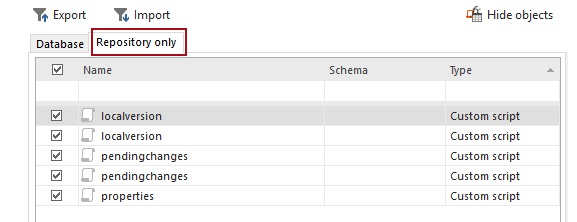Applies to
ApexSQL Source Control
Summary
This article provides answers to FAQs about Object filtering feature in ApexSQL Source Control.
Content:
Q: How to exclude objects from source control?
A: Objects can be excluded from source control during the initial database linking process, in the Object filtering step, or at later stage from ApexSQL Source Control options and the Object Explorer pane for a single object.
Q: Can I exclude object that exists only on source control repository?
Yes. It can be done from the Object filtering tab in the ApexSQL Source Control Options form by selecting Repository only tab in the list of all objects:

Q: Are excluded object shown in the Action center?
A: No. No. Any change made on excluded objects won’t be registered by ApexSQL Source Control and won’t be shown in the Action center tab.
Q: Can I include already excluded objects?
A: Excluded objects can be included again at any time. Also, if some objects are excluded during the database linking process, they can be included later from the ApexSQL Source Control options or from the Object Explorer pane context menu.
Q: If I exclude some object, does that means that it will be deleted from the source control repository?
A: No, it will be preserved on the repository.
Q: Does using the shared database development model policies affect excluded objects?
A: Yes it does affect excluded objects, if they are excluded locally. Policies are introduced in order to protect the database and its flow must be followed, so any override of it can cause issues. In order to prevent objects to be affected by database policies, objects must be excluded under the Global settings tab, in the ApexSQL Source Control options.
Q: If I change an object what will happen with a dependent object if it is excluded?
A: It will be changed in the database, as needed to maintain integrity, but only if database check-out policy is set to Optional. Even in this case, ApexSQL Source Control will detect only changes on the included object.
Q: Can I edit an excluded object if the database check out policy of permissive or restrictive is set?
A: Yes, in case the object is excluded under the Global settings tab, from the ApexSQL Source Control options.
Q: Can I share the object filtering settings among the team?
A: Yes. It can be done by using the Export/Import buttons in ApexSQL Source Control options, under the Objects filtering tab.
Q: How are included\excluded objects presented in Object explorer?
A: All objects under source control are marked with blue dot icon  in the Object Explorer pane, while unlinked objects don’t have any icon.
in the Object Explorer pane, while unlinked objects don’t have any icon.
Q: If an object is excluded under the Global settings tab, can I include it under the Local settings tab?
A: No, objects cannot be included under the Local settings tab, unless they are included under the Global settings tab.
Q: What is the difference between Local and Global filtering?
A: The difference is that the Global filtering allows modifying an object regardless of the database policy settings, while the locally filtered objects are affected by database policy settings. Also, global filtering affects all users in the shared model, while the local filtering is related to a single user.
Q: Can I use Global filtering in the dedicated model?
A: No, global filtering is implemented for the shared model only.
Q: Why I can’t export global filtering object selection?
A: There is no need to export object selection in the Global settings tab, because it affects all users, without the need to load (export/import) object selection.









